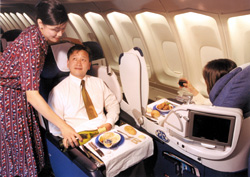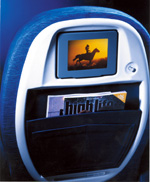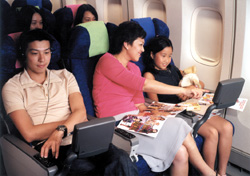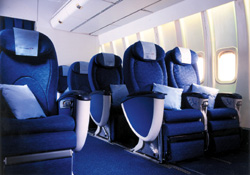 Online
Edition
Online
Edition | From
the editor Letters to the editor Milestone Answerman Periscope Campus Life Social Issues People Photo Features Education Channel Culture & Leisure Science |
| Last
Issue Archive |
| About
Varsity Advertise Media Links CUHK homepage JLM homepage |
Related
Links
British
Airways
![]()
Air travel
Lounge in the sky
By Irene Lam
Sit back and relax. Enjoy sweet dreams on the plane.
Miss Louisa Wong is a spokeswoman for British Airways.
“Passengers want the kind of sleep just like the one they have at home, so fully flat beds which are transformed from passengers seats will be installed,?said Miss Wong.
Such seats have been designed by UK-based design agency Tangerine and British Airways.
Said Miss Wong: “It is an armchair-style seat with a footrest. It can be transformed into a 6-foot fully flat bed by pressing a button.?/font>
The footrests are adjustable in height and pivot. Passengers can swivel them round completely or stow them away.
These seats are arranged in forward and rearward facing pairs.
“Passengers will sit beside their neighbours in an opposite direction, so they will not be disturbed even when others leave their seats,?said Miss Wong.
To enhance privacy, there are screens between seats. It is up to passengers?decisions to draw it.
A “smart seat?is another proposed seat design aiming at introducing tailor-made seats.
Smart seats will be available in about 5 years.
Said Miss Wong: “Smart seats are able to read body temperature and will automatically match it by adjusting its surface temperature.?/font>
Moreover, these seats scan passengers?height and weight.
Said Miss Wong: “By obtaining data of passengers?height and weight, the air pockets packed inside the seats will inflate and deflate to match the shape of their spines.
“All passengers will be assigned swipe cards in which their physical data are stored.
“These data will be downloaded each time so as to provide instantly tailored-made seats.?
Apart from seat design, seat arrangement swill also be changed.
“Passengers? seats will be extended to the wings as well. There will be a triangular seating plan where passengers?seats are configured in wide rows in the middle,?said Miss Wong.
“It is believed that both fuel and space can be economised with such changes.?/font>
These advancements will not only be found on planes, but also at customs and immigration checkpoints.
The traditional tedious check-in procedures will be replaced by biometrics.
Miss Wong said that they will rely on passengers?voices, fingerprints and iris recognition instead of passports for identity checks.
In spite of having comfortable seats, some passengers still experience physical discomfort such as dizziness and ear pain.
The abrupt change in atmospheric pressure results in ear pain.
“Pressure drops with increasing height and so does temperature. At the height of 30 km, pressure is one-tenth of that on the ground,?said Prof. Wong Hong Kuen of the Department of Physics at The Chinese University of Hong Kong.
Said Prof. Wong: “Before the plane takes off, the cabin should be sealed to keep the ground pressure inside. After taking off, the equipped pressure controlling system operates.
“Sometimes because of the late response by the pressure controlling system, passengers still get painful ears before the plane levels off at 35,000 feet.?/font>
Meanwhile, compressed gas sprays may leak or explode owing to changes in pressure. Therefore, some airlines restrict the quantity of sprays passengers bring on board.
The use of electrical appliances and mobile phones are also restricted.
“When the plane is landing or taking off, all electrical appliances and items with dry batteries are banned,?said Miss Lilian Wong, a flight attendant.
According to Prof. Wong, the use of these items may generate electromagnetic waves with frequencies similar to those emitted by planes.
These items may impose risks to the safety of the flight.
The ventilation system inside the cabin is an essential part as well.
“The total volume of air is exchanged every 2 to 3 minutes.
“Twenty cubic-feet of air is provided to each passenger, on average,?said Miss Wong.
“There are
particulate filters to remove bacteria and virus. They are the same as
those used in hospitals and theatres.?/font> ![]()
|
Courtesy
of British Airways
 |
|
Courtesy
of British Airways
 |
 |
 Private entertainment: Individual televisions are now available on some commercial aircraft. |